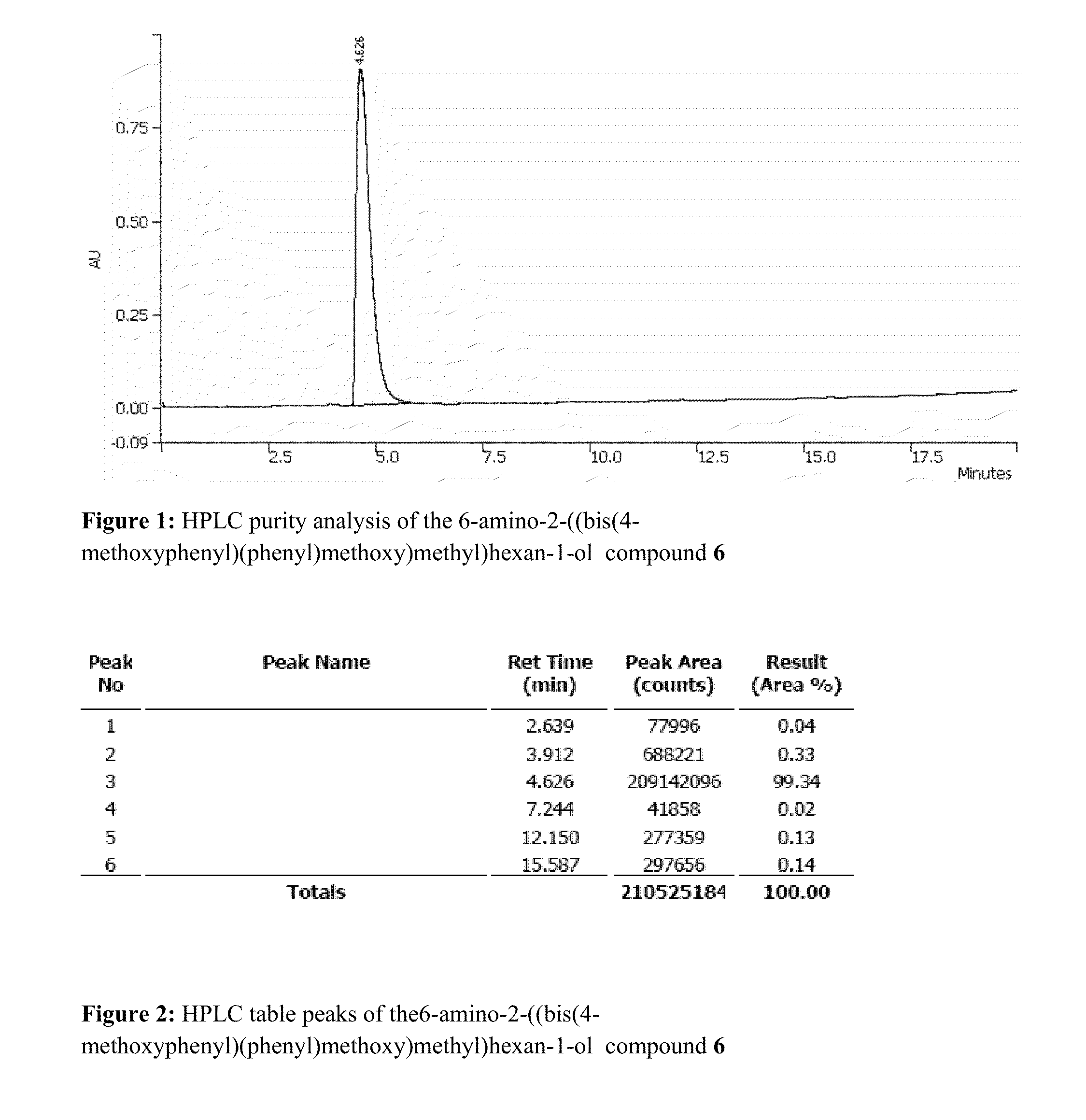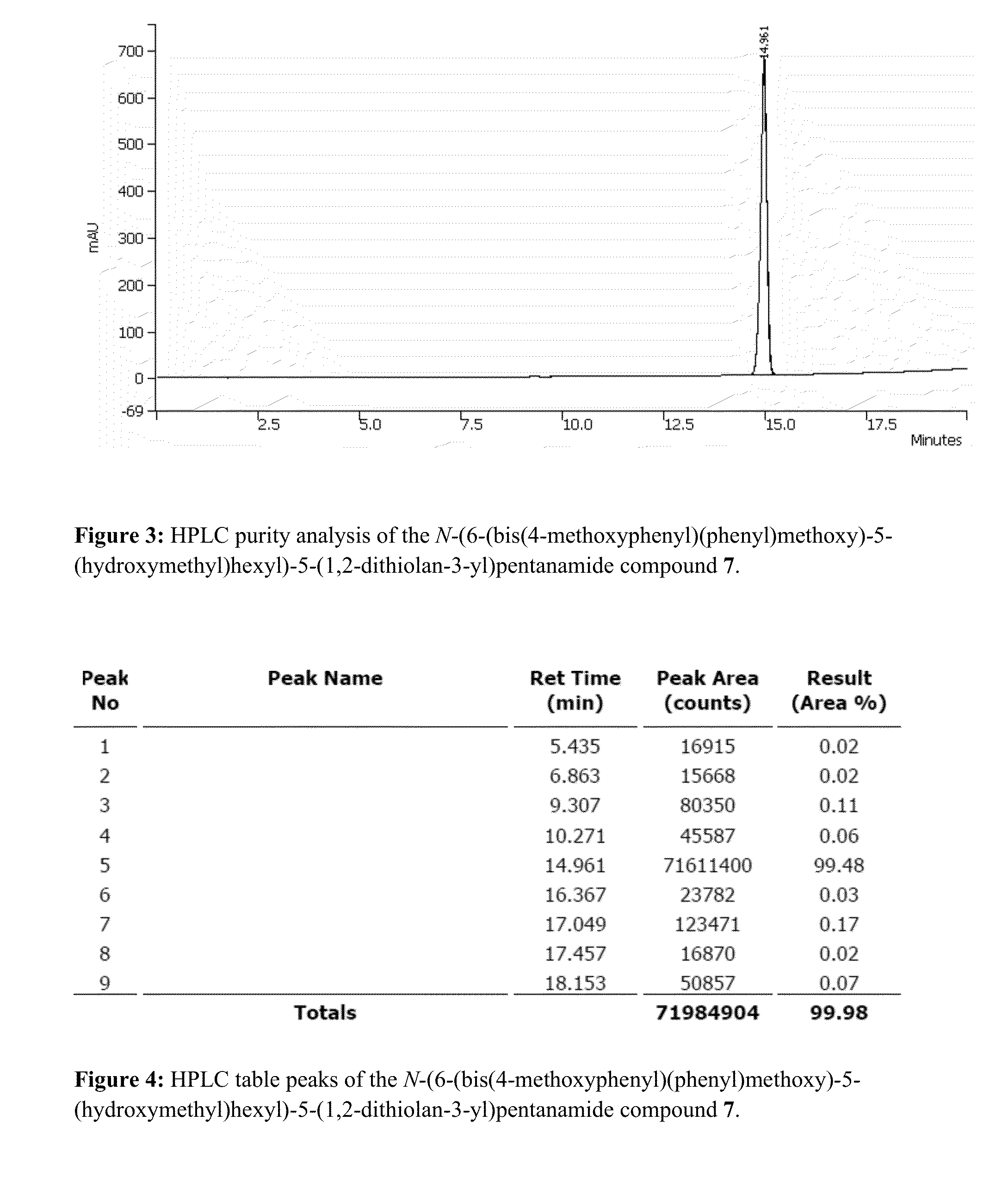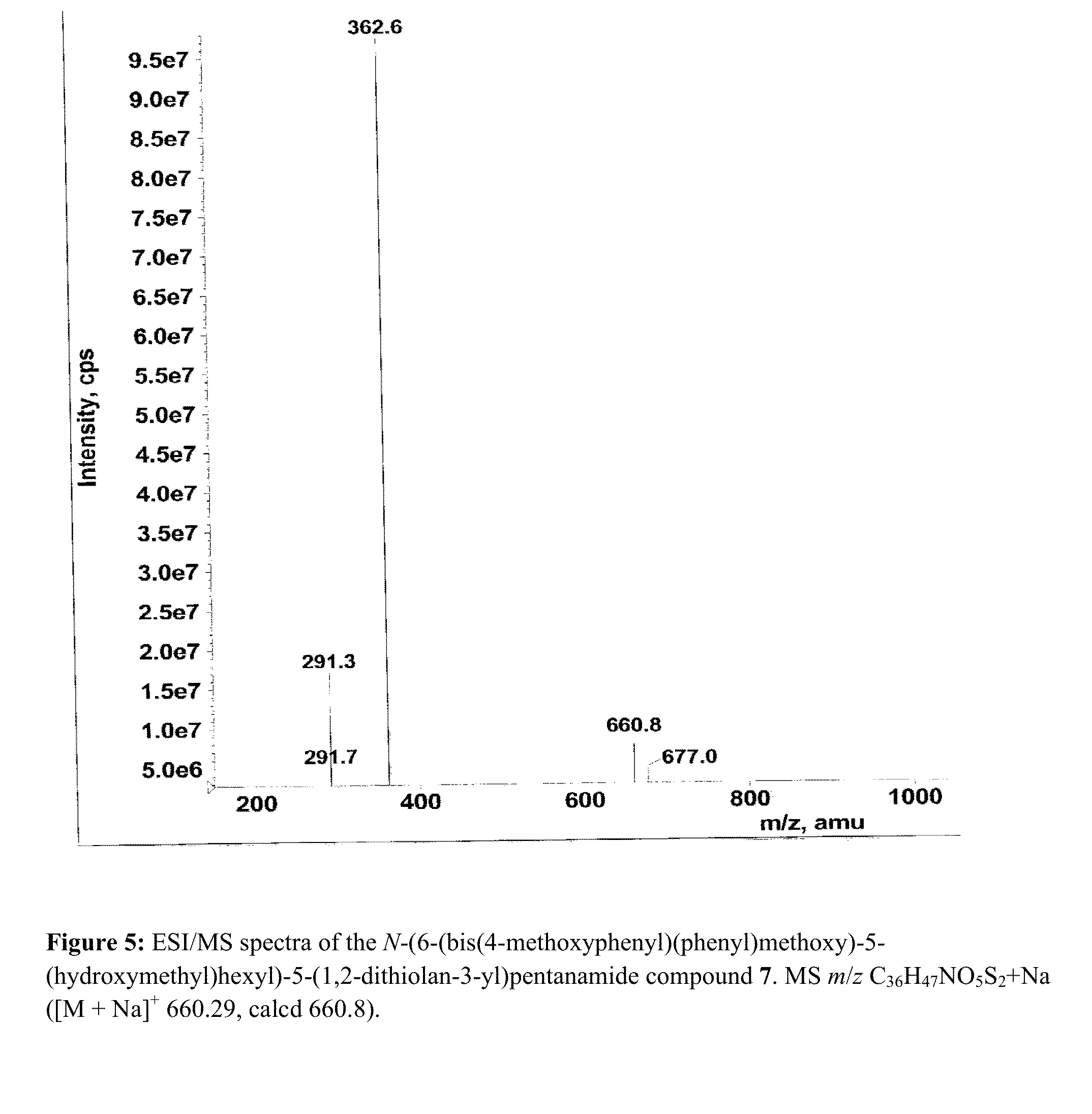Dithiolane Based Thiol Modifier For Labeling and Stronger Immobilization of Bio-Molecules On Solid Surfaces
a technology of biomolecules and thiols, applied in the field of nucleic acid chemistry, can solve the problems of limiting the application of these probes in solutions, oligonucleotide chain cleavage, and relative poor yield of final oligonucleotides
- Summary
- Abstract
- Description
- Claims
- Application Information
AI Technical Summary
Benefits of technology
Problems solved by technology
Method used
Image
Examples
example 1
S6-amino-2-((bis(4-methoxyphenyl)(phenyl)methoxy)methyl)hexan-1-ol (6)
[0132]Compound 1 (10 g, 14.9 mmol) was dissolved in 20% NH3 in MeOH (100 mL) in a sealed bottle. After stirring the reaction at room temperature for 16 h, it was evaporated to dryness and purified by silica gel column chromatography using (0-20% MeoH in CHCl3) with 1% triethylamine throughout the column to afford the target compound 6 (5.7 g, 85%). Rf=0.1 (10% Methanol in Chloroform, v / v). HPLC analysis single peak at 4.62 min (45 to 98% acetonitrile in 0.1M TEAA buffer) and purity is 99.34%.
example 2
N-(6-(bis(4-methoxyphenyl)(phenyl)methoxy)-5-(hydroxymethyl)hexyl)-5-(1,2-dithiolan-3-yl)pentanamide (7)
[0133]Thioctic acid (2.4 g, 11.8 mmol) was suspended in anhydrous N,N′-dimethylformamide (30 mL) and EDC.HCL (3.45 g, 18.2 mmol) was added to this. After stirring the reaction for 30 min, clear solution was obtained. Amine compound 6 (4.1 g, 9.1 mmol) was added to this at room temperature. After stirring the reaction for 16 h at room temperature, it was evaporated to dryness and purified by silica gel column chromatography using (80-100% EtOAC in hexane) to afford the target compound 7 (4.5 g, 77%). Rf=0.5 (EtOAc); MS m / z C36H47NO5S2+Na ([M+Na]+ 660.29, calcd 660.8); 1H NMR (CDCl3) 8.01 (s, 1H), 7.23-7.42 (m, 9H), 6.80-6.85 (m, 4H), 5.43 (s, 1H), 3.79 (s, 6H), 3.53-3.79 (m, 2H), 3.08-3.26 (m, 5H), 2.60-2.68 (m, 1H), 2.41-2.62 (m, 2H), 2.23-2.30 (m, 1H), 2.10-2.16 (m 2H), 1.80-1.93 (m, 2H), 1.60-1.76 (m 4H), 1.41-1.52 (m, 2H), 1.11-1.40 (m, 6H). HPLC analysis single peak at 14.41 m...
example 3
6-(5-(1,2-dithiolan-3-yl)pentanamido)-2-((bis(4-methoxyphenyl)(phenyl)methoxy)methyl)hexyl 2-cyanoethyl diisopropylphosphoramidite (1)
[0134]DMT-dithiolane coupled compound 7 (3.3 g, 5.1 mmol) was dried by coevaporation with anhydrous CH3CN (1×100 mL) and dried over-night on high vacuum pump then dissolved in anhydrous THF (50 mL). To this was added N,N′-diisopropylethylamine (2.7 mL, 15.5 mmol) and cooled in an ice cold water bath. After bubbling the argon for 25 min, 2-cyanoethyl N,N′-(diisopropyl)phosphoramidochloridite (1.27 mL, 5.69 mmol) was added under complete argon atmosphere and the reaction mixture was stirred in ice-cold water bath for 1 h, whereupon it was diluted with EtOAc (100 mL). The organic phase was washed with saturated aqueous NaHCO3 (100 mL), and saturated aqueous NaCl (100 ml). The combine aqueous phase was back-extracted with EtOAc (250 mL). The combined organic phase was evaporated to dryness, and the resulting residue was purified by silica gel column chrom...
PUM
| Property | Measurement | Unit |
|---|---|---|
| Temperature | aaaaa | aaaaa |
| Structure | aaaaa | aaaaa |
| Purity | aaaaa | aaaaa |
Abstract
Description
Claims
Application Information
 Login to View More
Login to View More - R&D
- Intellectual Property
- Life Sciences
- Materials
- Tech Scout
- Unparalleled Data Quality
- Higher Quality Content
- 60% Fewer Hallucinations
Browse by: Latest US Patents, China's latest patents, Technical Efficacy Thesaurus, Application Domain, Technology Topic, Popular Technical Reports.
© 2025 PatSnap. All rights reserved.Legal|Privacy policy|Modern Slavery Act Transparency Statement|Sitemap|About US| Contact US: help@patsnap.com



